购物车
全部删除  您的购物车当前为空
您的购物车当前为空
别名 Ubiquitin carboxyl extension protein 80, ubiquitin B, Ubiquitin, UBCEP2, UBCEP1, UBCEP 2, UBCEP 1, UBC, UBB, UBA80, UBA52, UBA 80, UBA 52, UB, RS27A, RPS27A, RPS 27A, Polyubiquitin-C, Polyubiquitin-B, MGC8385, HMG20, FLJ25987
Anti-Ubiquitin Polyclonal Antibody 是一种 Rabbit 抗体,靶向 Ubiquitin。Anti-Ubiquitin Polyclonal Antibody 可用于 FCM,ICC/IF,IF,IHC-Fr,IHC-P,WB。
Anti-Ubiquitin Polyclonal Antibody 是一种 Rabbit 抗体,靶向 Ubiquitin。Anti-Ubiquitin Polyclonal Antibody 可用于 FCM,ICC/IF,IF,IHC-Fr,IHC-P,WB。
| 规格 | 价格 | 库存 | 数量 |
|---|---|---|---|
| 50 μL | ¥ 1,175 | 5日内发货 | |
| 100 μL | ¥ 1,970 | 5日内发货 | |
| 200 μL | ¥ 2,795 | 5日内发货 |
| 产品描述 | Anti-Ubiquitin Polyclonal Antibody is a Rabbit antibody targeting Ubiquitin. Anti-Ubiquitin Polyclonal Antibody can be used in FCM,ICC/IF,IF,IHC-Fr,IHC-P,WB. |
| 别名 | Ubiquitin carboxyl extension protein 80, ubiquitin B, Ubiquitin, UBCEP2, UBCEP1, UBCEP 2, UBCEP 1, UBC, UBB, UBA80, UBA52, UBA 80, UBA 52, UB, RS27A, RPS27A, RPS 27A, Polyubiquitin-C, Polyubiquitin-B, MGC8385, HMG20, FLJ25987 |
| Ig Type | IgG |
| 交叉反应 | Human,Mouse,Rat (predicted:Pig) |
| 验证活性 | 1. Blank control (black line): HepG2. Primary Antibody (green line): Rabbit Anti-Ubiquitin antibody (TMAB-01928) Dilution: 1 μg/Test; Secondary Antibody: Goat anti-rabbit IgG-AF488 Dilution: 0.5 μg/Test. Negative control (white blue line): PBS Isotype control (orange line): Normal Rabbit IgG Protocol The cells were fixed with 4% PFA (10 min at room temperature) and then permeabilized with 90% ice-cold methanol for 20 min at-20°C. The cells were then incubated in 5% BSA to block non-specific protein-protein interactions for 30 min at room temperature. Cells stained with Primary Antibody for 30 min at room temperature. The secondary antibody used for 40 min at room temperature. 2. Blank control (Black line): Molt4 (Black). Primary Antibody (green line): Rabbit Anti-Ubiquitin antibody (TMAB-01928) Dilution: 1 μg/10^6 cells; Isotype Control Antibody (orange line): Rabbit IgG. Secondary Antibody (white blue line): Goat anti-rabbit IgG-AF647 Dilution: 1 μg/test. Protocol The cells were fixed with 4% PFA (10 min at room temperature) and then permeabilized with 90% ice-cold methanol for 20 min at room temperature. The cells were then incubated in 5% BSA to block non-specific protein-protein interactions for 30 min at room temperature. Cells stained with Primary Antibody for 30 min at room temperature. The secondary antibody used for 40 min at room temperature. 3. Sample: Ubiquitin protein at 100ng; Primary: Anti-Ubiquitin (TMAB-01928) at 1:300 dilution; Secondary: HRP conjugated Goat-Anti-rabbit Igg (secondary antibody) at 1: 5000 dilution; Predicted band size: 8.5 kDa Observed band size: 8.5 kDa 4. Paraformaldehyde-fixed, paraffin embedded (rat colon tissue); Antigen retrieval by boiling in sodium citrate buffer (pH6.0) for 15 min; Block endogenous peroxidase by 3% hydrogen peroxide for 20 min; Blocking buffer (normal goat serum) at 37°C for 30 min; Antibody incubation with (Ubiquitin) Polyclonal Antibody, Unconjugated (TMAB-01928) at 1:400 overnight at 4°C, followed by a conjugated secondary for 20 min and DAB staining. 5. Paraformaldehyde-fixed, paraffin embedded (Human skin carcinoma); Antigen retrieval by boiling in sodium citrate buffer (pH6.0) for 15 min; Block endogenous peroxidase by 3% hydrogen peroxide for 20 min; Blocking buffer (normal goat serum) at 37°C for 30 min; Antibody incubation with (Ubiquitin) Polyclonal Antibody, Unconjugated (TMAB-01928) at 1:400 overnight at 4°C, followed by operating according to SP Kit (Rabbit) instructionsand DAB staining. 6. Paraformaldehyde-fixed, paraffin embedded (Mouse pancreas); Antigen retrieval by boiling in sodium citrate buffer (pH6.0) for 15 min; Block endogenous peroxidase by 3% hydrogen peroxide for 20 min; Blocking buffer (normal goat serum) at 37°C for 30 min; Antibody incubation with (Ubiquitin) Polyclonal Antibody, Unconjugated (TMAB-01928) at 1:400 overnight at 4°C, followed by operating according to SP Kit (Rabbit) instructionsand DAB staining. 7. HepG2 cell; 4% Paraformaldehyde-fixed; Triton X-100 at room temperature for 20 min; Blocking buffer (normal goat serum) at 37°C for 20 min; Antibody incubation with (Ubiquitin) polyclonal Antibody, Unconjugated (TMAB-01928) 1:100, 90 minutes at 37°C; followed by a conjugated Goat Anti-Rabbit IgG antibody at 37°C for 90 minutes, DAPI (blue) was used to stain the cell nucleus.  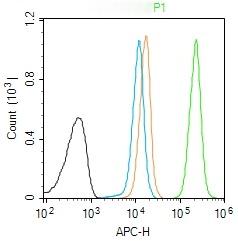 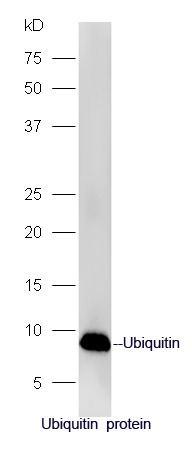 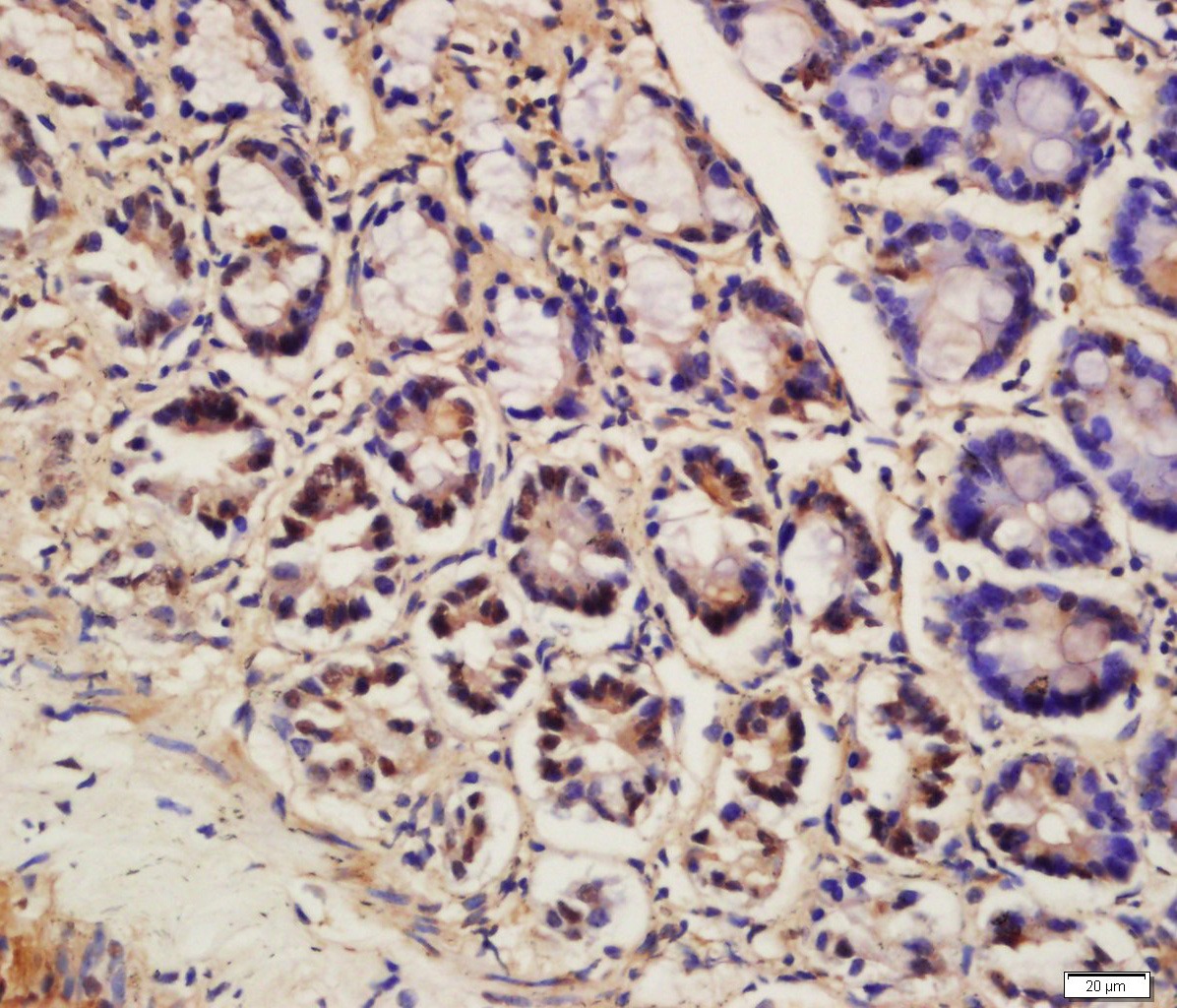 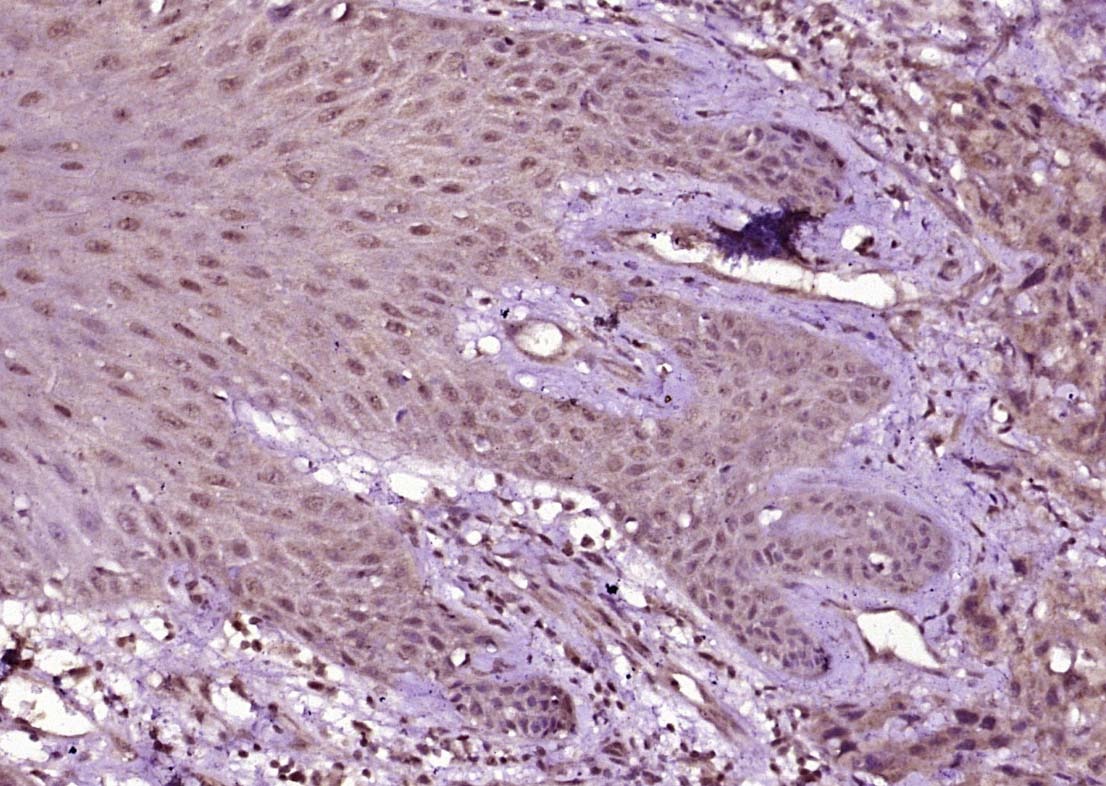 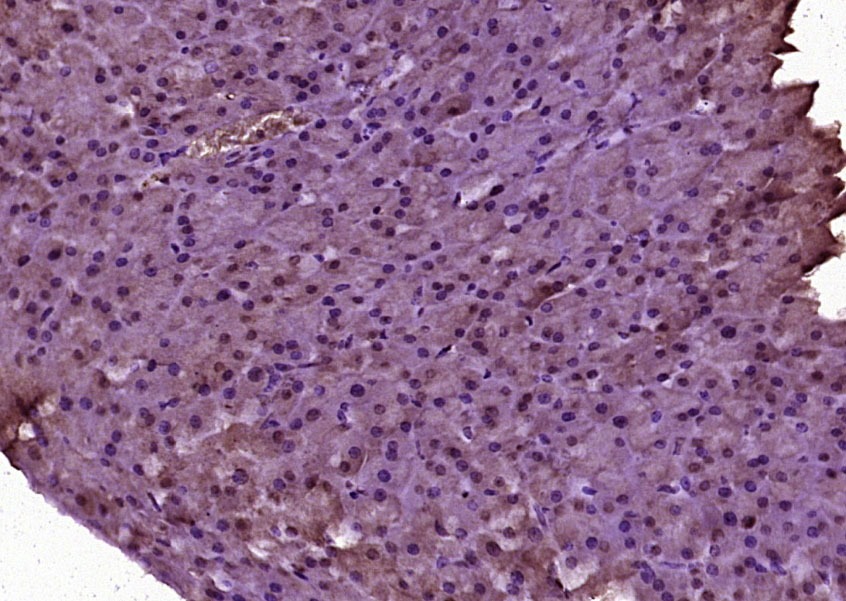 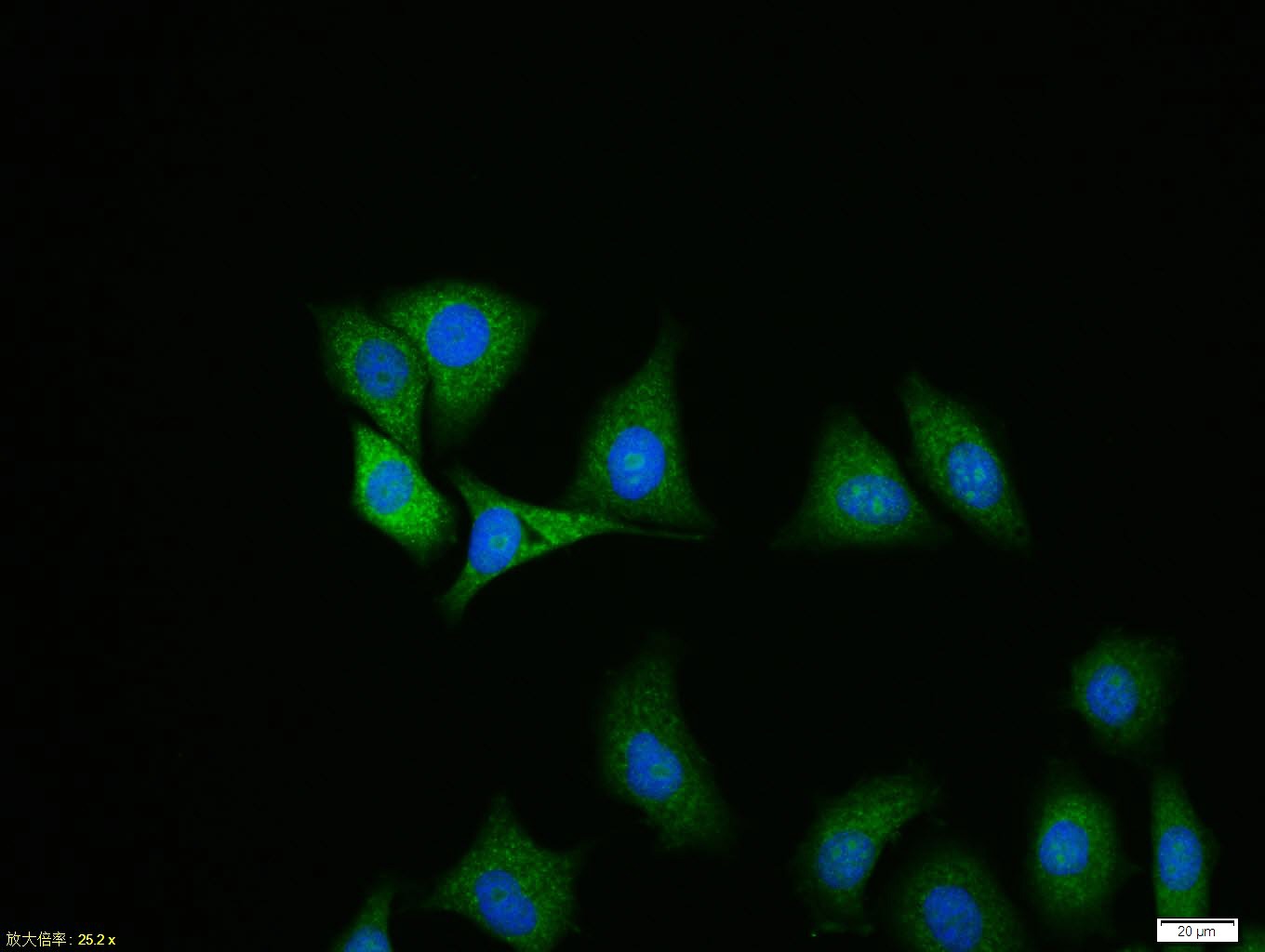 |
| 应用 | FCMICC/IFIFIHC-FrIHC-PWB |
| 推荐剂量 | WB: 1:500-2000; IHC-P: 1:100-500; IHC-Fr: 1:100-500; ICC/IF: 1:100; IF: 1:100-500; FCM: 1ug/Test |
| 抗体种类 | Polyclonal |
| 宿主来源 | Rabbit |
| 亚细胞定位 | Cytoplasm. Nucleus. |
| 构建方式 | Polyclonal Antibody |
| 纯化方式 | Protein A purified |
| 性状 | Liquid |
| 缓冲液 | 0.01M TBS (pH7.4) with 1% BSA, 0.02% Proclin300 and 50% Glycerol. |
| 浓度 | 1 mg/mL |
| 研究背景 | This gene encodes ubiquitin, one of the most conserved proteins known. Ubiquitin has a major role in targeting cellular proteins for degradation by the 26S proteosome. It is also involved in the maintenance of chromatin structure, the regulation of gene expression, and the stress response. Ubiquitin is synthesized as a precursor protein consisting of either polyubiquitin chains or a single ubiquitin moiety fused to an unrelated protein. This gene consists of three direct repeats of the ubiquitin coding sequence with no spacer sequence. Consequently, the protein is expressed as a polyubiquitin precursor with a final amino acid after the last repeat. An aberrant form of this protein has been detected in patients with Alzheimer's disease and Down syndrome. Pseudogenes of this gene are located on chromosomes 1, 2, 13, and 17. Alternative splicing results in multiple transcript variants. [provided by RefSeq, Aug 2013] |
| 免疫原 | KLH conjugated synthetic peptide: human Ubiquitin |
| 抗原种属 | Human |
| 基因名称 | UBB |
| 基因ID | |
| 蛋白名称 | Polyubiquitin-B |
| Uniprot ID | |
| 研究领域 | Proteasome,Ubiquitin |
| 功能 | Ubiquitin exists either covalently attached to another protein, or free (unanchored). When covalently bound, it is conjugated to target proteins via an isopeptide bond either as a monomer (monoubiquitin), a polymer linked via different Lys residues of the ubiquitin (polyubiquitin chains) or a linear polymer linked via the initiator Met of the ubiquitin (linear polyubiquitin chains). Polyubiquitin chains, when attached to a target protein, have different functions depending on the Lys residue of the ubiquitin that is linked: Lys-6-linked may be involved in DNA repair; Lys-11-linked is involved in ERAD (endoplasmic reticulum-associated degradation) and in cell-cycle regulation; Lys-29-linked is involved in lysosomal degradation; Lys-33-linked is involved in kinase modification; Lys-48-linked is involved in protein degradation via the proteasome; Lys-63-linked is involved in endocytosis, DNA-damage responses as well as in signaling processes leading to activation of the transcription factor NF-kappa-B. Linear polymer chains formed via attachment by the initiator Met lead to cell signaling. Ubiquitin is usually conjugated to Lys residues of target proteins, however, in rare cases, conjugation to Cys or Ser residues has been observed. When polyubiquitin is free (unanchored-polyubiquitin), it also has distinct roles, such as in activation of protein kinases, and in signaling. |
| 分子量 | Theoretical: 8.5 kDa. |
| 颜色 | Transparent |
| 物理性状 | Liquid |
| 储存方式 | Store at -20°C or -80°C for 12 months. Avoid repeated freeze-thaw cycles. |
| 运输方式 | Shipping with blue ice. |
评论内容